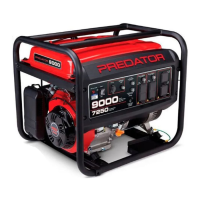Page 5For technical questions, please call 1-888-866-5797.ITEM 59206
SAFETYSETUPOPERATIONMAINTENANCE
38. Do not operate the Generator with known
leaks in the engine’s fuel system.
39. When spills of fuel or oil occur, they must be
cleaned up immediately. Dispose of fluids and
cleaning materials as per any local, state, or
federal codes and regulations. Store oil rags in
a bottom-ventilated, covered, metal container.
40. Keep hands and feet away from moving parts. Do
not reach over or across Generator while operating.
41. Before use, check for misalignment or binding
of moving parts, breakage of parts, and any
other condition that may affect the Generator’s
operation. If damaged, have the Generator
serviced before using. Many accidents are
caused by poorly maintained equipment.
42. Use the correct generator for the application.
Do not modify the generator or its engine,
and do not use the generator for a
purpose for which it is not intended.
43. Extension Cord - Make sure your extension cord
is in good condition. When using an extension
cord, be sure to use one heavy enough to carry
the current your product will draw. An undersized
extension cord will cause a drop in line voltage
resulting in loss of power and overheating.
The following table shows the correct
cord size to use depending on cord length
and nameplate ampere rating. If in doubt,
use the next heavier gauge. The smaller the
gauge number, the heavier the cord.
RECOMMENDED MINIMUM WIRE GAUGE FOR EXTENSION CORDS
CURRENT
(AMPS)
Load @
120V
(WATTS)
Load @
240V
(WATTS)
0 ~ 50 ft 50 ~ 75 ft 75 ~ 100 ft
2 240 480 18 AWG
4 480 960 18 AWG 16 AWG
6 720 1440 18 AWG 16 AWG 14 AWG
8 960 1920 16 AWG 12 AWG
10 1200 2400 16 AWG 14 AWG 12 AWG
15 1800 3600 14 AWG 12 AWG 10 AWG
20 2400 4800 12 AWG 10 AWG
25 3000 6000 12 AWG 10 AWG 8 AWG
30 3600 7200 10 AWG 8 AWG
35 4200 8400 8 AWG 6 AWG
40 4800 9600 6 AWG

